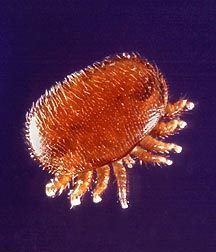Scientific name Varroa Higher classification Varroidae | Rank Genus Subclass Acari | |
 | ||
Family VarroidaeDelfinado & Baker, 1974 Lower classifications Varroa destructor, Varroa jacobsoni | ||
Varroa survivor
Varroa is a genus of parasitic mites associated with honey bees, placed in its own family, Varroidae. The genus was named for Marcus Terentius Varro, a Roman scholar and beekeeper. The condition of a honeybee colony being infested with Varroa mites is called varroosis (also, incorrectly, varroatosis).
Contents
Varroa mites are recognised as the biggest pest to honeybees worldwide, and are believed to be the single largest contributing factor in the modern-day decline of honeybees, due to their ability to transmit diseases such as deformed wing virus to larval or pupating bees, resulting in death or severe deformity of the pupae.
How to check for varroa mites
History and behavior
Varroa mites feed off the bodily fluids of adult, pupal, and larval honey bees, and may carry viruses that are particularly damaging to the bees (e.g., deformed wings, and IAPV), and accordingly they have been implicated in colony collapse disorder. Research has indicated that alone, neither Varroa mites nor deformed wing virus are particularly deadly, yet together they can pose an incredible risk to colonies.
Varroa mites were first discovered in Java about 1904, but are now present in all honey bee populations except Australia, Isle of Man and northern parts of Norway. They were discovered in the United States in 1987, in New Zealand in 2000, and in the United Kingdom in 1992 (Devon).
Bee-breeding efforts to develop resistance against Varroa are ongoing. The USDA has developed a line of bees which uses Varroa-sensitive hygiene to remove reproductive mites. This line is now being distributed to beekeepers to be used as part of their integrated pest management programs.
Species
The genus Varroa contains these species:
Resistance
Some honey bees strains have become resistant to Varroa. These strains have developed Varroa-sensitive hygiene behavior and can detect and remove Varroa in brood.
